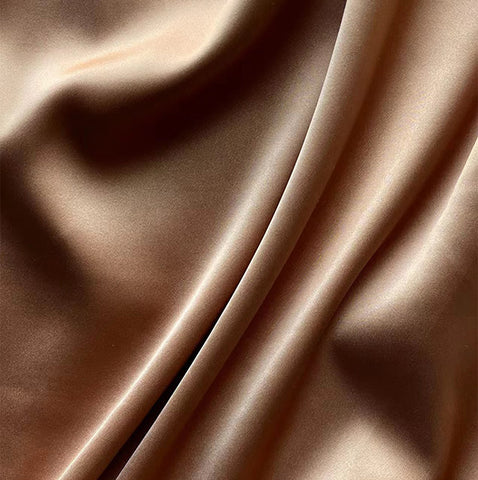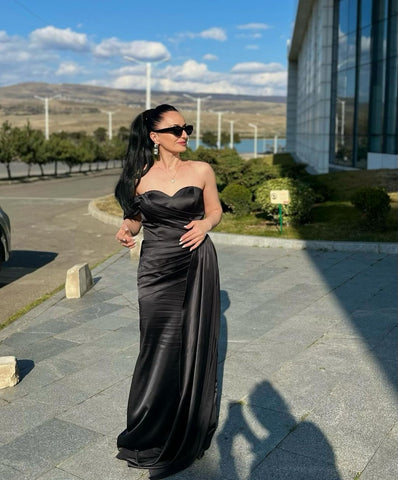

Satin is a popular material choice for garments, accessories, and sometimes even furniture. You have likely seen it when you were shopping. However, you may be wondering what, exactly, satin is.
In this article, you will learn all about satin, from the different types of satin to its history and origin!

Many people think that satin is a type of fabric. This is only partly true. Technically, satin is a type of weave that can make up many types of fabrics. Therefore, the name “satin” refers to the weave of the fabric, not the textile.
Satin has some common characteristics, which makes it typically easy to identify. “Satin is a woven fabric with a high silk content, known for its luxurious sheen and smooth drape”, according to fashion historian Leslie Ceci. For this reason, it is often used for evening wear, bridal or bridesmaid dresses, and similar garments.
Another feature is that the outer side of the fabric, also known as the “face,” is the shiny side. The inner side of the fabric, called the “wrong” side, is duller and coarser.
Since satin is the weave that makes up many different fabrics, there are lots of textiles that are classified as satin. We will discuss the many types of satin further in this article.

Image Source: Wikipedia
Satin is often confused with silk. They have some similar characteristics and are sometimes very similar in appearance. This makes sense because satin production began in China, where it was woven exclusively with silk! But there are many differences between satin and silk.
Satin weave hails from the port city of Quanzhou. However, the city’s name in Arabic was Zaitun– where the name satin comes from! In medieval China, when satin originated, many travelers were traveling along the Silk Road.
Ideas, goods, and innovations made their way very far with the help of the Silk Road. Satin is one of those. Both the fabric itself and the weaving techniques traveled to the Middle East, where they were adopted and production began to spread.
A little later on, European countries started to produce satin, too. Italy was the first Western country to produce satin in the 12th century. By the 14th century, satin’s popularity had spread across Europe.

Image Source: Wikipedia
Many fashion historians agree that satin’s popularity for bridesmaid dresses dates back to the Victorian Era. The Victorian Era is the years 1837 through 1901, during the reign of Queen Victoria in Britain and Ireland.
During this time, satin was a status symbol. Mary Mitchell, a curator at the Museum at FIT, has explained that “it symbolized elegance and wealth.”. Satin was not being manufactured in Britain and was being imported. Importing the fabric made it more expensive, which meant only the wealthy class could afford to wear it.

Satin is known for being silky smooth to the touch. You can feel its softness when you run your hand along the fabric and wear it! Unlike some other types of fabric, satin is not scratchy or itchy.
Satin also has an elastic texture, which makes for a good fit and a beautiful drape! Most types of satin are lightweight and breathable when they are on your body.

Once upon a time, satin was made from silk, like when the technique first came out of China. These days, though, there are different blends of fibers woven together to create the textile.
Many types of satin are made from synthetic fibers now. This is more cost-effective for manufacturers. It also means that the fabric is more accessible to everyday consumers– unlike in the Victorian Era, when it was only a fabric for the elite.
Polyester is one of the synthetic fibers that is often used to create satin. It can also be made with rayon or nylon.
Some of the natural fibers that can be used in satin are silk, as mentioned above, and cotton. The fiber content can vary greatly between different cuts of satin, which is why it is important to be aware of the fabric details before you buy!
There are various types of satin and this is based on the type of fibers used in the weave. As well as the category of satin weave used. Below are a few types of satin and their characteristics:

Image Source: Pinterest
Antique satin is made with weft threads from unevenly spun yarns. It is also woven at either a 5 or 8 harness. The fabric is characterized by the slubs and subtle texture on its face. It is often used as a decorative fabric, often as for drapes in interior spaces.

Image Source: Pinterest
Baronet satin is well known for being an incredibly lustrous type of satin. To achieve superior luster, rayon fabrics are used for the warp in the weave, while cotton is used for the weft threads.

Image Source: Pinterest
Charmeuse comes from a French word meaning “charmer”. This type of satin is popular because it is lightweight and has a fantastic drape. It is a great choice for satin evening gowns or bridesmaid dresses. Charmeuse has the shiny side and dull side of the fabric that we all expect from satin, too.

Messaline is one of the satins that is well suited for bridesmaid dresses or other garments. It is very lightweight and also features a high shine. Its shine makes it more eye-catching, while its light weight means it can mold to the body better for a flattering fit.

Image Source: Pinterest
Duchess satin is a heavy, stiff type of satin. It does not have as much shine or luster as many other kinds of satin. However, one of the good things about duchess satin is that it is great for dyeing. It can be dyed different colors and then used for clothing or upholstery.

Image Source: Pinterest
Crepe back satin is reversible! On one side, the fabric has the glossy appearance typical of satin. However, the other side of the satin has a pebbled, crepe texture. This makes garments made with crepe-back satin even more versatile.

An alternative to satin is sateen. They are both similar in appearance– even their names sound similar!
Sateen is a textile that is made by weaving cotton fibers together. On the other hand, satin is more commonly made with synthetic fibers such as polyester or rayon. Sateen utilizes a similar weave structure to satin, but the use of cotton fibers creates less of a sheen on the face side of the fabric.
Sateen features a duller sheen than satin, but both fabrics are known for their shine and the same type of weave pattern. If you like a bit of shine, but the high gloss of satin is too much, sateen could be a great choice!
Some people think satin is mainly useful for making bridal dresses and evening gowns. That is true, but satin can be used for more than just dresses. Satin is used in a variety of applications, including interior decoration and accessories. To mention a few uses:

Satin can be used for many applications. The most obvious is clothing. We see satin often in eveningwear, gowns, and bridal or bridesmaid fashion.
However, there are some dressy ready to wear pieces made out of satin, too. A satin tank top is one of the most popular trends in many areas. It is the perfect piece for the evening, and looks stylish but effortless.

Satin is also used in accessories. It can be found in handbags, shoes, scarves, and more! In street fashion, we see satin accessories used in two ways:

Image Source: Wikipedia
You may not think of this particular application, but satin can even be used for furniture. For instance, the Palace of Versailles is filled with furniture, and most of it is upholstered with satin!
These days, satin armchairs or couches can still be found in shops, whether the items are brand new or vintage. It’s a great way to lend some grandeur to your interiors.

This is one of the earliest uses of satin in Europe, specifically. Satin is used to decorate furniture, such as chairs and cushioned furniture. Aside from furniture, satin is used to make interior finishes such as curtains.
There are many reasons that bridesmaid dresses are made out of satin. Satin has a particularly elegant, luxurious look that brides and bridesmaids want to emulate!

One of the first reasons for choosing satin for a bridesmaid dress is the fabric’s appearance. Satin is smooth, glossy, and drapes well across the body. It is flattering on many different body types. The wearer will look glamorous and put together.

How does it feel to wear a dress that hangs effortlessly on the body? Awesome, if you would agree with me. Satin fabric is rich in high-quality fibre making it very pliable. According to Lisa Ferla, bridal boutique owner; “Satin offers a luxurious look at various price points. Whether it's pure silk or a high-quality synthetic blend, satin bridesmaid dresses always exude a touch of elegance”.
Satin bridesmaid dress also has a way of enhancing the silhouette and dress variations. And effortlessly revealing the body figure of the bridesmaid. As a result, it is an ideal bridesmaid dress fabric.

Bridesmaid dresses produced from satin fabric are long-lasting and durable. Such that the dress can be reused subsequently for other events. Without showing any signs of wear and tear. This feature is characteristic of satin fabrics, most especially, polyester satin. The tautness of satin weaves is responsible for its durability. Making it a good fabric option for bridesmaids' dresses.

Satin is versatile and impartial, whether you want an extravagant or minimalist look for bridesmaid dresses. "Satin is a timeless fabric that photographs beautifully. It reflects light in a way that flatters all body types, making it a versatile choice for bridesmaid dresses”, says celebrity stylist, Mark Ingram.
Also, the varying sides of the satin fabric, gloss and matte give room for even more versatility. Both sides of satin can be used to sew the bridesmaid dress. This enables the bridesmaid to be flexible in their appearance.

Another reason designers prefer satin is that it does not wrinkle easily. However, this is determined by the thickness of the satin. The thicker the satin fabric, the less wrinkle-prone it is.
Unlike other fabrics, which wrinkle after sitting for a few minutes. Bridesmaid dresses made of satin do not wrinkle easily, even after sitting during bridal events.
Satin bridesmaid dresses! Whether you are looking for a simple style or an extravagant style. These satin bridesmaid dress trends are your go-to choice. These designs are not only classy and sophisticated but also contemporary. To mention a few of the high-end satin bridesmaid dress trends:

The one-shoulder satin dress is a fantastic trendy bridesmaid style. This style is an ideal choice for a less extravagant bridesmaid appearance.

Off-shoulder dress is the latest trend revolving in the fashion industry. Off-shoulder satin bridesmaid dress is suitable for a vintage-themed wedding.

The strapless satin bridesmaid dress is an ideal bridesmaid design for a classy look. This trending style gives a sophisticated and perfect look for an indoor wedding theme.

Satin bridesmaid dress dresses and asymmetric hemlines are a part of the trendy style. The asymmetric hemline adds beauty and glamour to the bridesmaid dress.

The slit satin dress is one of the top bridesmaid dress trends. Whether it is a thigh-high or side slit, it gives the bridesmaid dress an extra touch of romance. This dress trend also creates a fascinating and elegant look.

The cowl neck bridesmaid dress is a trendy neckline variation style. This neckline brings out the beauty in the bridesmaid dress by making it even more unique. It can be incorporated into any wedding theme.
The shiny and slippery nature of satin makes it stressful to work with. But, we will walk you through the process of sewing a satin bridesmaid dress:

When you are making a satin bridesmaid dress, there are two main techniques you can use to design the dress.
The first technique is draping. Draping is when a designer takes the fabric and pins it to the mannequin in different ways to find the best way it drapes and falls on the body. Satin is a great fabric for this type of design because one of its characteristics is a superior drape.
After draping, the designer can create a pattern from the draped dress to make other dresses in the same style.

The other design process is to make a pattern based on the idea in the designer’s head. A pattern is, essentially, the blueprint of pieces that need to be cut from the fabric and sewn together to create a garment.
Patterns can either be made by hand on special drafting paper, or they can be made digitally with Computer Aided Design software.
Once the pattern is made, the designer can cut the pieces needed for the satin bridesmaid dress, and stitch it together to construct it! Then it is ready to be purchased.
Some designers are more tactile and prefer the draping process, while other designers are more technical and prefer to draft the pattern instead. A lot of this is down to personal preference.

Some of satin’s unique characteristics can make it difficult to sew. For example, its silky texture can make it slippery to work with. To avoid errors, only cut one layer of satin at a time. Otherwise, the fabric could slip and you could make a cutting error.
You should also stitch satin very slowly so that the fabric does not slip on the sewing machine feed. Plus, satin is delicate and prone to pulls or warping and stitch bunching. These can happen if you sew satin too quickly or carelessly.
Stitch and pin marks show up easily on satin. To avoid having noticeable marks, be careful where you pin the fabric– avoid any spots that would be clearly visible when the garment is being worn.
Work slowly and carefully, as mentioned previously, to avoid any errors requiring you to remove stitching. This could cause visible needle marks or even tears if you are not cautious enough when taking out the stitches!

You can buy satin fabric in many places, but it also depends on certain factors. For instance, are you looking to buy many rolls of satin fabric, or just enough for one dress? Another thing to consider is your location. If you are near the city, you will have more options on where to find satin fabric.
You can try going to your local fabric or craft shop to find satin fabric. This is best for when you are only looking for small amounts of fabric, as they will not usually have a very large stock of the same color and fabric type.
If you are looking for larger quantities of fabric, try going to a wholesale fabric distributor or fabric warehouse if you have one in your area! They are much more likely to have the amounts you need, as compared to a hobby shop.
Another great option for small and large quantities of satin fabric is online shopping! There are so many online fabric vendors offering different types of satin fabric. This can also be helpful for those who do not live near many fabric shops or larger wholesale fabric vendors.

Due to the fragility of satin, if you wash it incorrectly, it can easily cause permanent damage to the satin surface. We generally recommend that you choose professional satin care. And for those who like to clean bridesmaid dresses by themselves, we recommend you read this professional article: How to Wash Satin Bridesmaid Dresses, which can make your dress as clean and tidy as the day you bought it.
When you are considering satin fabric, it is important to remember that it is usually made with synthetic fibers. Manmade fibers like polyester or rayon in satin are not biodegradable. Creating them also uses fossil fuels.
However, a more sustainable option is to use recycled satin. Sometimes, synthetic fibers that cannot biodegrade are recycled into new materials. This gives them a second life and cuts down on the production of new manmade textiles.